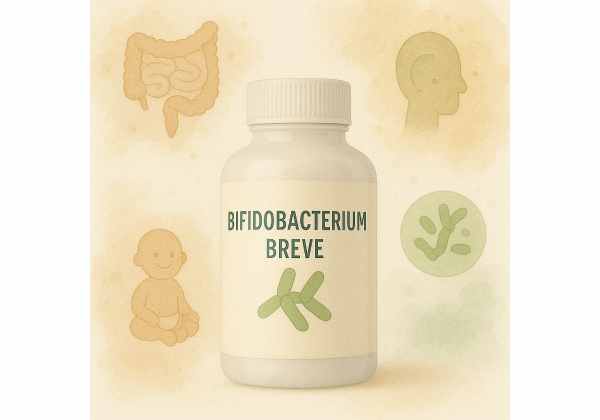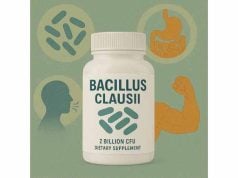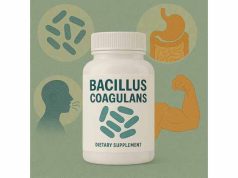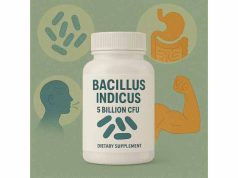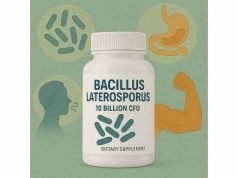Bifidobacterium breve is a versatile probiotic bacterium recognized for its unique ability to support digestive health, enhance immunity, and promote balanced wellness for all ages. Naturally present in the guts of infants, children, and adults, B. breve is widely studied for benefits such as easing constipation, improving gut barrier function, and even helping manage allergies or eczema. Its gentle, evidence-backed action makes it a popular addition to supplements for babies, children, and adults seeking robust microbiome support. Whether you want to optimize digestion, bolster your body’s defenses, or support healthy skin and weight, B. breve offers scientifically supported solutions when used as part of a daily wellness routine.
Key Takeaways
- Bifidobacterium breve supports regular digestion, gut barrier integrity, and healthy bowel movements.
- It may reduce allergy and eczema risk, support immune function, and aid infant and child gut development.
- Generally well-tolerated with minimal, temporary digestive side effects; safe for daily use in most people.
- Best results come from consistent supplementation and a diet rich in prebiotic fiber.
- Consult a healthcare provider before use if immunocompromised, critically ill, or if giving to infants under six months.
Table of Contents
- Bifidobacterium breve Overview and Distinctive Probiotic Characteristics
- Mechanisms of Action, Scientific Basis, and Microbiome Benefits of Bifidobacterium breve
- Health Benefits, Uses, and Evidence for Bifidobacterium breve Supplementation
- Safety Profile, Side Effects, and Interactions of Bifidobacterium breve
- Optimal Dosage, Forms, and Best Practices for Bifidobacterium breve
- Frequently Asked Questions About Bifidobacterium breve
Bifidobacterium breve Overview and Distinctive Probiotic Characteristics
Bifidobacterium breve is a Gram-positive, anaerobic bacterium and one of the earliest colonizers of the human gut. It belongs to the Bifidobacterium genus, a family of beneficial microbes found predominantly in the intestines of healthy infants, children, and adults.
What Makes Bifidobacterium breve Stand Out?
- Early Colonizer: B. breve is especially abundant in the intestines of breastfed infants, playing a crucial role in shaping gut health from birth. Its presence supports healthy digestion, immune maturation, and resistance to infections in early life.
- Versatility Across Ages: Unlike some probiotics that decline with age, B. breve can persist throughout childhood and adulthood, maintaining its positive effects as the gut ecosystem evolves.
- Adaptation to Fiber-Rich Diets: B. breve is uniquely skilled at fermenting a wide variety of plant fibers and prebiotic oligosaccharides (complex sugars found in breast milk, fruits, and vegetables), producing health-promoting short-chain fatty acids (SCFAs) that fuel gut cells and maintain gut pH.
Where Is B. breve Found?
- Naturally occurring: Found in the human gut, breast milk, and in lower amounts in some fermented dairy and plant foods.
- Supplemental forms: Available as capsules, powders, and drops—often in multi-strain blends with other Bifidobacteria and Lactobacilli for synergistic support.
Key Biological Functions
- SCFA Production: Ferments prebiotics into acetate, lactate, and other SCFAs, which help nourish intestinal cells and foster an environment that discourages harmful bacteria.
- Barrier Defense: Supports the integrity of the intestinal lining, reducing the risk of “leaky gut” and associated inflammation.
- Immune Modulation: Helps balance the immune response, especially in infants and children, potentially reducing allergy and eczema risk.
Who Benefits from Bifidobacterium breve?
- Infants and children: For healthy gut development, immune support, and allergy risk reduction.
- Adults: For regularity, metabolic support, and digestive comfort.
- Those with allergies, eczema, or mild digestive issues: May notice significant improvement with daily use.
Core Strains and Clinical Use
- Commonly studied strains include B. breve M-16V, BR03, and Yakult’s B-3, each with unique strengths for immune support, allergy management, and gut wellness.
Bifidobacterium breve’s resilience and multifaceted actions make it a cornerstone probiotic for people of all ages seeking foundational gut health and immune protection.
Mechanisms of Action, Scientific Basis, and Microbiome Benefits of Bifidobacterium breve
Bifidobacterium breve exerts a powerful influence on digestive and immune health through a set of highly specialized mechanisms. Understanding how B. breve works inside the body highlights its value as a daily supplement.
1. Fermentation of Prebiotics and Complex Carbohydrates
- Fiber breakdown: B. breve breaks down dietary fibers (such as inulin, GOS, and FOS) that humans cannot digest, transforming them into beneficial SCFAs like acetate and lactate.
- Benefits of SCFAs: These fatty acids fuel colon cells, strengthen the gut barrier, lower gut pH, and inhibit harmful bacteria.
2. Mucosal Barrier Protection
- Reinforcing gut lining: By producing SCFAs and stimulating mucin (a protective mucus protein) production, B. breve helps keep the intestinal barrier intact, protecting against “leaky gut” and systemic inflammation.
- Blocking pathogens: Occupies binding sites on the gut wall, physically crowding out disease-causing bacteria and reducing their ability to colonize.
3. Immune System Modulation
- Balancing immunity: B. breve interacts with immune cells in the gut lining, increasing beneficial regulatory T cells and anti-inflammatory cytokines, while reducing excessive immune responses associated with allergies and autoimmune conditions.
- Enhanced antibody production: Supports the creation of immunoglobulin A (IgA), a crucial antibody for mucosal defense in the digestive tract.
4. Protection Against Harmful Microbes
- Acid production: Lowers gut pH, making it less hospitable for pathogens like E. coli and Clostridium difficile.
- Bacteriocin secretion: Produces natural antimicrobial compounds that specifically target and inhibit harmful microbes.
5. Synergy with Other Microbes
- Supporting a diverse microbiome: B. breve encourages the growth of other beneficial bacteria, maintaining overall gut balance and resilience.
6. Role in Infant Gut and Brain Development
- In infants, B. breve is vital for early gut colonization, immune training, and possibly even cognitive development via the gut-brain axis.
Summary Table: Mechanisms and Effects
| Mechanism | Health Benefit |
|---|---|
| SCFA production | Nourishes gut lining, lowers inflammation |
| Mucosal defense | Protects against leaky gut, reduces allergies |
| Pathogen exclusion | Prevents infections, maintains gut balance |
| Immune modulation | Lessens allergy and eczema risk |
| Microbial synergy | Supports a healthy, diverse microbiome |
Through these mechanisms, Bifidobacterium breve supports both targeted health concerns and overall well-being.
Health Benefits, Uses, and Evidence for Bifidobacterium breve Supplementation
Bifidobacterium breve stands out for its diverse, evidence-backed health applications across the lifespan—from infancy to older adulthood. Here are its most important, research-supported benefits and uses:
1. Supporting Digestive Regularity and Comfort
- Relieves constipation: Regular B. breve supplementation is linked to improved stool frequency and softness in infants, children, and adults, making it a go-to option for mild to moderate constipation.
- Reduces bloating and discomfort: Helps balance gut flora, reducing gas, abdominal pain, and discomfort, especially in sensitive individuals.
2. Enhancing Infant and Child Health
- Immune development: Central to establishing a resilient, balanced immune system in infants and young children, especially those born via C-section or formula-fed.
- Reduces allergy and eczema risk: Studies show supplementation lowers the incidence and severity of allergic reactions and atopic dermatitis in infants and toddlers.
- Colic relief: May help reduce crying and fussiness in infants with colic when included in multi-strain probiotic formulas.
3. Preventing and Managing Diarrhea
- Acute and antibiotic-associated diarrhea: Regular use can shorten the duration and reduce the severity of infectious and antibiotic-associated diarrhea in both children and adults.
4. Supporting Gut Barrier Integrity
- Reduces leaky gut: By enhancing mucosal defense, B. breve helps protect against increased gut permeability and the resulting inflammatory and autoimmune issues.
5. Managing Allergies and Eczema
- Allergy modulation: Balances immune responses, decreasing the risk and severity of seasonal allergies, food allergies, and skin conditions such as eczema.
6. Metabolic and Weight Management
- Weight support: Emerging research suggests certain B. breve strains may play a role in weight management, helping support fat metabolism and prevent excessive weight gain, especially in children and adolescents.
7. Potential Cognitive and Mood Benefits
- Gut-brain axis: Early studies indicate possible benefits for mood, behavior, and stress resilience, especially in children with gut-brain or neurodevelopmental challenges.
Summary Table: Evidence-Based Benefits
| Health Area | B. breve Action | Research Strength |
|---|---|---|
| Digestive comfort/regularity | Improves stool frequency, relieves constipation | Strong (clinical) |
| Infant immune/allergy | Reduces allergies, supports development | Strong (clinical) |
| Diarrhea prevention | Reduces duration/severity | Moderate–strong |
| Eczema/skin | Lowers eczema risk/severity | Moderate–strong |
| Gut barrier protection | Prevents leaky gut, supports balance | Moderate |
| Weight/metabolic | Modest support for healthy weight | Preliminary |
| Mood/cognition | Early gut-brain support | Preliminary |
From easing digestive upsets to shaping immune balance and even supporting healthy weight, Bifidobacterium breve’s benefits are broad, well-studied, and applicable across all ages.
Safety Profile, Side Effects, and Interactions of Bifidobacterium breve
Bifidobacterium breve is celebrated for its excellent safety record and suitability for people of all ages—including infants, children, adults, and seniors. Like all probiotics, B. breve is generally considered very low risk for healthy individuals, but understanding possible side effects and when to seek guidance is key to confident, effective use.
1. Safety Overview and Regulatory Standing
- B. breve is classified as “Generally Recognized as Safe” (GRAS) by major food safety authorities and is approved for use in infant formulas, foods, and supplements worldwide.
- Its use in numerous clinical studies, especially in vulnerable populations like preterm infants and children, highlights its gentle action and low risk profile.
2. Typical Side Effects: What to Expect
Most people who take Bifidobacterium breve notice no side effects at all. When symptoms do appear, they are usually mild, brief, and limited to the digestive tract as the microbiome adjusts. Common effects may include:
- Temporary bloating or mild gas
- Softening or change in stool consistency
- Slight increase in bowel movements
- Transient mild abdominal discomfort
These symptoms usually disappear within a few days to a week. If side effects persist longer than two weeks, consult your healthcare provider.
3. Rare and Serious Reactions
- Severe allergic reaction: Extremely rare and almost always related to an ingredient in the supplement (such as milk proteins, soy, or fillers) rather than B. breve itself.
- Infection: Documented only in severely immunocompromised patients or those with critical illness. Symptoms include fever, persistent abdominal pain, or signs of sepsis. In these situations, all probiotics should be used only with physician oversight.
4. Populations Needing Special Caution
Certain groups should consult a healthcare professional before using B. breve or any probiotic supplement:
- Immunocompromised individuals: People with cancer, organ transplants, HIV/AIDS, or on immunosuppressive drugs.
- Hospitalized or critically ill patients: Always require medical supervision before starting probiotics.
- Premature infants and babies under six months: Should use only physician-approved products and dosing.
5. Drug, Food, and Supplement Interactions
- Antibiotics: Antibiotics can reduce the efficacy of probiotics by killing both harmful and beneficial bacteria. Take B. breve at least 2–3 hours apart from antibiotic doses for best effect.
- Other probiotics or prebiotics: Safe to use together; combinations may amplify mild digestive side effects initially.
- Allergens: Some supplements contain traces of milk, soy, gluten, or other allergens—check labels carefully, especially for those with food sensitivities.
6. Product Quality, Storage, and Shelf Life
- Always choose brands that clearly state the strain (e.g., B. breve M-16V), CFU count at expiration, and third-party testing.
- Follow storage instructions. Some products require refrigeration to maintain potency, while others are shelf-stable.
- Watch expiration dates to ensure the probiotic remains effective.
7. When to Discontinue Use and Seek Help
Stop taking B. breve and consult a healthcare professional if you experience:
- Persistent or worsening digestive symptoms beyond two weeks
- Severe allergic reactions (swelling, difficulty breathing, rash)
- Signs of infection (fever, chills, ongoing abdominal pain)
Safety and Interactions Table
| Safety Aspect | Guidance |
|---|---|
| Most users | Safe, very low risk |
| Mild effects | Bloating, gas, stool changes (temporary) |
| At-risk groups | Use under doctor supervision |
| Severe reactions | Extremely rare, usually not from B. breve |
| Drug interactions | Separate from antibiotics |
| Allergen caution | Check labels for milk, soy, gluten |
With proper selection and usage, Bifidobacterium breve is one of the safest ways to support gut and immune health naturally.
Optimal Dosage, Forms, and Best Practices for Bifidobacterium breve
To enjoy the full range of Bifidobacterium breve’s benefits, it’s essential to select the right dosage, form, and routine for your needs. Here’s your guide to effective supplementation for every age and goal.
1. Recommended Dosages by Age and Use
- Infants and young children: Products typically provide 1–5 billion CFUs (colony-forming units) daily, often in powdered or drop form. Use only pediatric-specific formulas for infants under one year and follow your healthcare provider’s guidance.
- Older children and adults: Most supplements offer 5–20 billion CFUs per day. This range is safe for daily use and has been shown to support digestive and immune function.
- Multi-strain blends: B. breve is often included with other Bifidobacteria or Lactobacilli for enhanced synergy and broad-spectrum support. Confirm per-strain CFU counts on the label.
2. Supplement Forms and Delivery
- Capsules/Tablets: Most common for adults; easy for routine use and precise dosing.
- Powders/Sachets: Can be mixed into cool drinks, yogurt, or soft foods—ideal for children or those who dislike swallowing pills.
- Drops: Designed for infants and toddlers, delivering specific strains in a liquid base.
- Functional foods: Some yogurts, fermented milk drinks, and fortified foods contain B. breve, but actual dosages vary widely and are rarely standardized.
3. When and How to Take B. breve
- With or without food: B. breve can be taken at any time; however, taking with a meal, especially one containing some fat, may improve survival through stomach acid.
- Timing: Consistency matters more than time of day. Take your supplement at the same time daily for best results.
- Antibiotic use: Space probiotics 2–3 hours away from antibiotic doses, or start supplementation after finishing antibiotics to restore gut balance.
4. Duration of Use
- Short-term: For acute issues (diarrhea, after antibiotics, travel), use for 2–4 weeks.
- Long-term: Ongoing daily use is safe and recommended for general digestive, immune, and allergy support.
5. Supporting Probiotic Growth
- Dietary prebiotics: Eating plenty of plant-based fibers (bananas, oats, asparagus, onions, garlic) helps B. breve thrive.
- Hydration and lifestyle: Drinking water, reducing processed foods, and managing stress can further enhance probiotic benefits.
6. Adjusting Dosage for Maximum Benefit
- Increase: If you don’t notice results after several weeks and experience no side effects, it’s safe to increase within label directions.
- Decrease: If digestive symptoms persist, lower the dose or pause use briefly before resuming.
Dosage and Administration Table
| Group | Typical Dose (CFU/day) | Form | Duration/Timing |
|---|---|---|---|
| Infants | 1–5 billion | Drops/powder | Daily/doctor-guided |
| Children | 2–10 billion | Powder/capsule | Daily/with food |
| Adults | 5–20 billion | Capsule/tablet | Daily/ongoing |
| Acute recovery | 5–20 billion | Any | 2–4 weeks |
Choosing a trusted brand, following recommended use, and pairing B. breve with gut-friendly habits sets the stage for optimal results at every life stage.
Frequently Asked Questions About Bifidobacterium breve
What is Bifidobacterium breve used for?
B. breve is used to improve digestive regularity, support infant gut and immune development, relieve constipation and diarrhea, reduce allergy and eczema risk, and help maintain a balanced gut microbiome.
Is Bifidobacterium breve safe for babies and children?
Yes, B. breve is safe for healthy infants and children when used in appropriate doses and age-specific formulas. Always consult your pediatrician for infants under six months or with health concerns.
Can Bifidobacterium breve help with allergies or eczema?
Studies show B. breve supplementation may lower the risk and severity of allergies and atopic dermatitis, especially when started early in life.
Are there side effects with Bifidobacterium breve?
Side effects are rare and typically mild—mostly temporary digestive changes like gas or softer stools. Severe reactions are extremely uncommon.
How do I take Bifidobacterium breve for best results?
Take a trusted supplement daily, ideally with food, and maintain a fiber-rich diet to feed the probiotic. Follow storage and dosage instructions for your chosen product.
Can I take Bifidobacterium breve with other probiotics or medications?
Yes, it’s safe with other probiotics and prebiotics. If taking antibiotics, space doses by several hours. Check with your doctor if you have complex medical needs.
How long should I take Bifidobacterium breve?
Short courses (2–4 weeks) help with acute issues; daily, ongoing use is safe for long-term gut and immune support.
Disclaimer:
The information in this article is for educational and informational purposes only and should not be used as a substitute for professional medical advice, diagnosis, or treatment. Always seek advice from your physician or qualified healthcare provider with questions regarding any medical condition or supplement use. Never ignore or delay seeking professional advice because of something you’ve read here.
If you found this article helpful, please share it on Facebook, X (formerly Twitter), or your favorite social media channel. Your support helps us provide more evidence-based wellness content for everyone. Thanks for reading, and follow us for more health news and tips!


